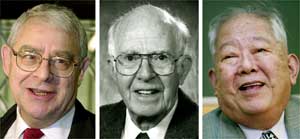
Physicist Dr. Raymond Davis Jr.
CHEMISTRY
Proteins and other organic molecules tend to be complex and relatively massive, which makes identifying and analyzing them a difficult job. Yet if you're designing new drugs, it's crucial to understand the proteins involved in diseases and the chemistry of drug molecules that might fight them.
Thanks to this year's chemistry Nobel laureates, that's a lot easier than it used to be. In the late 1980s, John Fenn, 85, of Virginia Commonwealth University, and Koichi Tanaka, 43, of Shimadzu Corp. in Kyoto, Japan, independently invented techniques that extended a common analytical tool called mass spectrometry — that is, sorting by mass — to much bigger and more complex molecules than had ever been possible. Among many other things, their work has led to new diagnostic tests for ovarian, breast and prostate cancers and for malaria, and earned the pair half of the approximately $1million prize.
The other half goes to Kurt Wthrich of, 64, of Swiss Federal Institute of Technology in Zurich and the Scripps Research Institute in San Diego. Like Tanaka and Fenn, Wthrich took an existing high-tech tool and refined it for use on organic molecules. In this case, the technology was nuclear magnetic resonance (better known in its medical diagnostic form as MRI). It works by bathing a lab sample or a human body with electromagnetic energy and carefully measuring how the atoms and molecules respond. Its not all that difficult when youre looking for something big — a tumor inside the brain, for example.
What Wthrich did in the early 1980s was to find a way to analyze the signal from something dramatically smaller. It involves a lot of mathematics — measuring the distances between hundreds of pairs of hydrogen atoms in a given molecule and then combining all of the distances to yield a three-dimensional diagram of the molecules shape. That lets biologists understand disease and drug proteins in a whole new way; it was Wthrichs technique, for example that led to an understanding of the detailed structure of prions, which are involved in Mad Cow disease. It has also been used to help screen new compounds for their potential effectiveness as drugs. And along with Fenns and Tanakas work, it will make the flood of information flowing from the sequencing of the human genome a bit easier to manage.

REUTERS
Winners of the Nobel Prize in Physics (from left): Dr. Riccardo Giacconi, Raymond Davis and Masatoshi Koshiba |
PHYSICS
If there were such a thing as an interstellar vision exam, humans would qualify as legally blind. Thats because all we can see is ordinary, visible light. But stars and galaxies shine with all sorts of other radiation as well. For their work in probing these otherwise invisible signals from space Raymond Davis, 87 of the University of Pennsylvania; Masatoshi Koshiba, 76, of the University of Tokyo; and the Italian-born U.S. citizen Riccardo Giacconi, 71, of Associated Universities Inc. in Washington, D.C, each got a share of the Nobel prize in Physics announced in Stockholm Tuesday.
Before Davis came along in the 1960s, physicists were convinced that the Sun's heat came from nuclear fusion the same process that powers the H-bomb — but they had no proof. But Davis realized that fusion reactions at the sun's core should generate neutrinos, elusive particles that would escape and fly all the way to, and through the Earth. He put a detector deep underground to screen out other stray particles, and, sure enough, there were the neutrinos.
That alone was Nobel-worthy work, but Davis also found that there were only about a third the predicted number of particles. Theorists struggled for decades to understand why; finally, in the late 1990s, Koshibas Super-Kamiokande detector in Japan proved that the missing neutrinos had really just converted into another form, undetectable by Davis's machine (for complex reasons, this also implied that neutrinos, long thought to be massless, actually do have a tiny mass.
Koshiba and Davis split half the Nobel for their neutrino work; Giacconi, meanwhile, gets the other half of the approximately $1 million prize. His achievement: building a series of X-ray telescopes that have laid bare the secrets of such exotic heavenly objects as quasars, black holes and super-dense neutron stars. And like Koshiba and Davis, he has helped to rectify humanitys cosmic myopia.
MEDICINE
The cells in our bodies die, not because they just run out of steam, but because their DNA tells them it's time to go — to make room for new cells, for example. When the process goes out of control, though, diseases like stroke, heart attack and degeneratative illnesses of the central nervous system can result; when it fails, you can get the unrelenting growth of cancer.
Programmed cell death, or apoptosis, is so important that the Nobel committee decided Monday to award this year's prize in Physiology or Medicine to three researchers who have uncovered its genetic basis. H. Robert Horvitz, 55, an American who works at the Massachusetts Institute of technology will share the award with two Britons: Sydney Brenner, 75, of the Salk Institute for Biological Studies in San Diego, and Sir John Sulston, 60, of the Wellcome Trust Sanger Institute, in Cambridge, England.
During the 1970s, the three began studying the genetics of C. elegans, a tiny worm. They eventually found that a specific set of genes tells cells when to die as part of the worms normal growth and development — and later, those same genes were found to exist in the human genome as well. Nobody has yet turned these discoveries into treatments that can turn cell-death genes on or off at will to fight disease. But researchers are working on them. And if such precisely targeted medicines do finally become available, Horvitz, Brenner and Sulston will be largely responsible.
